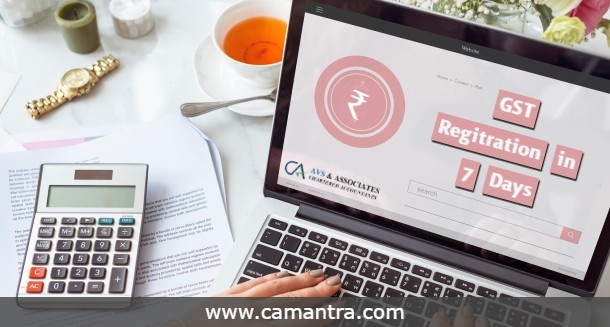The Goods and Services Tax (GST) has reshaped the tax structure in India. For many businesses, GST registration is mandatory. While it once seemed complex and time-consuming, recent government initiatives have significantly speed up the process.
This guide focuses on how your business can aim for GST registration within 7 days, thanks to these new streamlined procedures.
The Fast-Track to GST Registration:
The government and the Central Board of Indirect Taxes and Customs (CBIC) have been actively working to simplify GST registration. A key directive issued on April 17, 2025, instructs GST officers to avoid asking for unnecessary documents, aiming to make the process easier for new businesses. Now, GST registrations should be processed within seven working days from the application date, provided all information is correct. This is a big improvement from the previous longer processing times.
To ensure this faster timeline, GST officers are instructed to only request the documents listed in the GST registration form, FORM GST REG-01.
These typically include your
- PAN card
- Aadhaar card
- Business address proof
- Bank details
Any requests for additional documents now need approval from a senior officer .Furthermore, the use of technology for verification, like Aadhaar authentication and location-tagged photos, has reduced the need for physical inspections in many cases. These changes are part of the government’s Digital India and Ease of Doing Business 2.0 initiatives, designed to create a more efficient and transparent system.
Your 7-Day GST Registration Roadmap:
Getting your GST registration within 7 days is achievable by carefully following these steps and ensuring your application is accurate and complete:
- Step 1: Start on the GST Portal
Part A of Form GST REG-01
- Go to the official GST portal: www.gst.gov.in.
- Go to “Services” > “Registration” > “New Registration”.
- In Part A, provide your business’s legal name (as per your PAN), your PAN number, a valid email address, and a mobile number for OTP verification. Make sure all the details entered are correct.
- Select your State, Union Territory, District, and taxpayer type.
- Complete the CAPTCHA and submit. You’ll get your TRN by both email and text message.
- Step 2: Complete the Detailed Application
Part B of Form GST REG-01:
- Visit the GST portal again and choose “New Registration” from the “Registration” menu.
- Enter the TRN and CAPTCHA as shown, then hit “Proceed.”
- Authenticate using the OTPs sent to your registered mobile number and email.
- In the next step, complete Part B by supplying the necessary business details, including:
- Business details (name, structure, PAN).
- Details of promoters/partners/directors.
- Enter the authorized signatory’s details, upload a photograph
- Provide the address and proof of your main business location.
- For owned premises, provide any one of the latest property tax receipt, municipal khata copy, or electricity bill.
- For rented premises, a valid rent agreement and one of the ownership documents of the lessor are needed. If the rent agreement isn’t registered, also include the lessor’s ID proof. If the electricity or water connection is in your name as the tenant, that along with the rent agreement is sufficient.
- For shared premises, a consent letter, owner’s ownership proof, and their ID are required.
- Provide details of any additional business locations, if applicable.
- List the goods and services you offer along with their respective HSN/SAC codes.
- Your bank account details (account number, type, IFSC code, and proof like a cancelled cheque or passbook first page). While optional initially, it’s recommended.
- Any state-specific information if needed.
- Upload scanned copies of all necessary documents.
- Step 3: Prepare and Upload Your Documents:
- Have all required documents ready in the correct format and size. Commonly required documents include your PAN card, Aadhaar card, proof of business address, bank account details, and photographs. The specific documents vary by business type (Sole Proprietorship, Partnership, Company, HUF). Ensure clarity and legibility.
- Step 4: Verify and Submit:
- Navigate to the “Verification” page, review the declaration carefully, and submit your application.
- Verification can be done using a
- A Digital Signature Certificate (DSC) is required for all companies and LLPs.
- E-Signature (Aadhaar-based OTP), or
- Electronic Verification Code (EVC).
- For the fastest processing (aiming for 7 days), choose Aadhaar-based E-Signature if eligible. This can often eliminate the need for physical verification.8 Follow the on-screen prompts to authenticate your Aadhaar using OTP.
- Without Aadhaar authentication, a physical verification of your premises may be required, potentially extending the timeline.
- Step 5: Track Your Application and Respond to Queries:
- After submission, you will receive an ARN. You can use this ARN to check the status of your application on the GST portal by navigating to “Services” > “Registration” > “Track Application Status.
- Regularly check your email and the GST portal for any notices from the GST officer. If they need more information, you’ll receive a notice in Form GST REG-03.
- Ensure you respond to any queries or provide the required documents in Form GST REG-04 within seven working days to avoid any delays.
- GST officers are now expected to process standard applications (especially those with Aadhaar authentication) within 7 working days.
Tips for Faster GST Registration:
Looking to speed up your GST registration process and avoid complications? By staying organized and following a few key steps, you can significantly reduce processing time and avoid unnecessary delays.
Here are some practical tips to help you get your GSTIN faster:
- Be Accurate: Double-check all information before submitting.
- Have Documents Ready: Prepare clear, scanned copies of all required documents in advance.
- Use Aadhaar Authentication: If possible, opt for Aadhaar-based OTP verification.
- Respond Quickly: Monitor for and promptly reply to any notices from the GST officer.
- Use DSC if Needed: If your business requires a Digital Signature Certificate, ensure it’s valid and registered.
- Consider Expert Help: If you find the process complex, consider getting help from GST professionals.
How to Avoid Delays:
Delays in GST registration are often avoidable with the right approach. Small mistakes or oversights can slow down the process significantly. To help you stay on track and ensure a smooth registration experience, keep the following tips in mind:
- Avoid Errors: Inaccurate or incomplete information is a major cause of delays.
- Upload Clear Documents: Ensure all documents are legible and meet the portal’s requirements.
- Choose Aadhaar Authentication: Not opting for it can lead to longer processing.
- Respond to Queries Promptly: Delays in responding to notices will slow down your registration.
Important Note: While this guide aims for a 7-day registration, this is an estimated timeframe. The actual time can vary based on the accuracy of your application, the verification process by GST authorities, and how quickly you respond to any queries. Ensure all information and documents are accurate and complete for a smoother process.
With the recent improvements to the GST registration process, obtaining your GSTIN within 7 days is now a realistic goal for many businesses. By following this guide carefully and taking the necessary steps to ensure an accurate and complete application, you can navigate the process efficiently and join the GST system smoothly.

